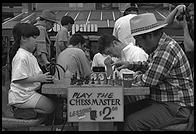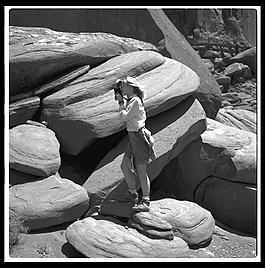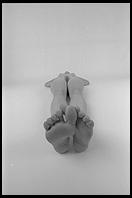
Mastering Black-and-White Photography
a review by Philip Greenspun; created 1998
Site Home : Photography : Mastering Black-and-White Photography

a review by Philip Greenspun; created 1998
Site Home : Photography : Mastering Black-and-White Photography
Mastering Black-and-White Photography by Bernhard J. Suess, 1995 Allworth. ISBN 1-880559-23-4. 240 pages. You can order this book from amazon.com .
 I once
got some email from a very courteous guy asking if he could use some of my
on-line images in a slide show for students. This was a surprise since so many
people just steal images for obviously commercial uses. Here was someone asking
for a non-commercial use! I said "sure" and eventually a package arrived with
this book, inscribed with a Thank You.
I once
got some email from a very courteous guy asking if he could use some of my
on-line images in a slide show for students. This was a surprise since so many
people just steal images for obviously commercial uses. Here was someone asking
for a non-commercial use! I said "sure" and eventually a package arrived with
this book, inscribed with a Thank You.
I let the book sit on my bedroom dresser for weeks. After all, I don't really do much black & white photography and I figured I was too experienced to benefit much from a book intended for beginners.
One night, I picked the book up around 1 am and couldn't put it down until I'd finished all 240 pages. If Suess's textbook lacks some of the depth and arcana of my cherished RIT textbook, it makes up for it with some very clear prose and drawings. Because Allworth didn't have a huge budget for color printing, they had to substitute intelligence and the line drawings here convey certain concepts better than I've ever seen them done.
Suess doesn't discuss leaf shutter efficiency, i.e., the tendency of leaf shutters to expose more than their marked value when the shutter speed is high and the aperture is small. If you've got a view camera loaded with Tri-X on a sunny day, this does matter. However, very few photography students will ever see a leaf shutter camera so perhaps it is best left out in a 240-page book. Does this mean the book isn't valuable for someone who intends to work with large format? No. On page 25 Suess has the only drawing I've ever seen that clearly explains why the same focal length lens is a telephoto on a 35mm camera but a normal lens on a view camera.
I like Suess's composition rules:

This book is much less imposing than my RIT textbook, much less slick and impersonal than other intro photography textbooks, and has a very high content/page ratio. I was pleasantly surprised and I think most beginners would benefit from reading Suess's book.
Note: Less than half the book is specific to black & white or darkroom work. So it is plenty useful for people who intend to stick to color slide or print film.
Text and photos copyright 1990-1998 Philip Greenspun